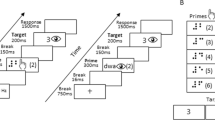Summary
Braille-like patterns were presented unilaterally to both tactual and visual modalities. The subject's task was to identify the location of three dots in a 2 × 3 six-dot pattern. Specifically, tactual versus visual presentation, dynamic versus static presentation of tactual stimuli, learning, and gender were examined in relation to cerebral hemisheric differences. Data were analyzed in terms of both the number of individual stimulus dots and the number of complete three-dot patterns correctly identified with regard to their spatial location. Although no reliable laterality differences were obtained with the tactual-static condition, owing to a significant interaction between learning and side of stimulus presentation, dot positions were reported reliably more accurately when presented in a dynamic fashion, i. e., scanned by the subject, to the right hand. For the visual modality, both correct reports of individual dot positions as well as correct reports of the entire patterns were reliably more accurate for stimulus presentations to the right visual field. Increased familiarity with the task, i. e., learning accross trials, generally increased report accuracy, particularly for static presentations to the left hand. The effect of gender was negligible. The results are dicussed in terms of their theoretical implications for differential cerebral hemispheric specializations in terms of differential processing strategies.
Similar content being viewed by others
References
Bach-y-Rita P (1979) Brain mechanisms in sensory substitution. Academic Press, New York, NY
Bakker DJ (1972) Temporal order in disturbed reading. University Press, Rotterdam
Bever TG (1975) Cerebral asymmetries in humans are due to the differentiation of two incompatible processes: Holistic and analytic. Ann NY Acad Sci 263:251–262
Bever TG, Chiarello RJ (1974) Cerebral dominance in musicians and nonmusicians. Science 185:137–139
Bliss JC, Crane HD, Link SW (1966) Effect of display movement on tactile pattern perception. Percept Psychophys 1:193–202
Carmon A (1971) Disturbances of tactile sensitivity in patients with unilateral cerebral lesions. Cortex 7:83–97
Carpenter M (1976) Human neuroanatomy, 7th edn. Williams & Wilkins, Baltimore, MD
Craig JC (1980) Modes of vibrotactile pattern generation. J Exp Psycho Hu Percept Perform 6:151–166
Efron R (1963) The effect of handedness on the perception of simultaneity and temporal order. Brain 86:261–284
Faglioni P, Scotti G, Spinnler H (1971) Spatial localization with brain damage. Brain 94:443–454
Fairweather H (1976) Sex differences in cognition. Cognition 4:231–279
Harris LJ (1978) Sex differences in spatial ability: possible environmental, genetic, and neurological factors. In: Kinsbourne M (ed) Asymmetrical function of the brain. University Press, Cambridge
Hermelin B, O'Connor N (1971) Functional asymmetry in the reading of Braille. Neuropsychologia 9:431–435
Kimura D (1966) Dual functional asymmetry of the brain in visual perception. Neuropsychologia 4:275–285
Kimura D (1969) Spatial localization in right and left visual fields. Can J Psychol 23:445–458
Kimura D (1973) The asymmetry of the human brain. Sci American 228:70–78
Kinsbourne M (1970) The cerebral basis of lateral asymmetries in attention. Acta Psychol 33:193–201
Kirk RE (1968) Experimental design: Procedures for the behavioral sciences. Brooks/Coole, Belmont, CA
Kirman JH (1979) Tactile pattern perception and tactile displays. In: Harmon L (ed) Proceedings of the Asilomar conference on interrelations of the communicative senses. (NSF Technical Report)
La Grone DW Jr (1942) An experimental study of the relationship of peripheral perception to factors in reading. J Exp Educ 11:37–49
Lake DA, Bryden MP (1976) Handedness and sex differences in hemispheric asymmetry. Brain Lang 3:266–282
Lechelt EC (1980) Laterality differences and shifts as a function of tactile temporal pattern complexity: Implications for differential processing strategies of the cerebral hemispheres. Psychol Res 41:319–333
Levy-Agresti J, Sperry RW (1968) Differential perceptual capacities in major and minor hemispheres. Proc U S Nat Acad Sci 1151
Loomis JM (1974) Tactile letter recognition under different modes of stimulus presentation. Percept Psychophys 16:401–408
McGlone J, Davidson W (1973) The relation between cerebral speech laterality and spatial ability with special reference to sex and hand preference. Neuropsychologica 11:105–113
McGlone J, Kertesz A (1973) Sex differences in cerebral processing of visuo-spatial tasks. Cortex 9:313–320
Milner B (1971) Interhemispheric differences and psychological processes in man. Br Med Bull 27:272–277
Milner B (1974) Hemispheric specialization: scope and limits. In: Schmitt FO and Worden FG (eds) The neurosciences third study program. MIT Press, Boston, MA
Milner B, Taylor L (1972) Right-hemisphere superiority in tactile pattern-recognition after cerebral commissurotomy: Evidence for nonverbal memory. Neuropsychologia 10:1–15
Nebes RD (1971) Superiority of the minor hemisphere in commissurotomized man for the perception of part-whole relations. Cortex 7:333–349
Papcun G, Krashen S, Terbeek D, Remington R, Harshman R (1974) Is the left hemisphere specialized for speech, language, and/or something else? J Acoust Soc Am 55:1285–1289
Rudel RG, Denckla MB, Spalten E (1974) The functional asymmetry of Braille letter learning in normal, sighted children. Neurology 24:733–738
Schwartz J, Tallal P (1980) Rate of acoustic change may underlie hemispheric specialization for speech perception. Science 207:1380–1381
Semmes J (1968) Hemispheric specialization: A possible clue to mechanism. Neuropsychologia 6:11–26
Sherrick CE (in press) Cutaneous communication. In: Neff WD (ed) Contributions to sensory physiology, vol 6. Academic Press, New York, NY
Smith MO, Chu J, Edmonston WE Jr (1977) Cerebral lateralization of haptic perception: Interaction of responses to Braille and music reveals a functional basis. Science 197:689–690
Varney NR, Benton AL (1975) Tactile perception of direction in relation to handedness and familial hendedness. Neuropsychologia 13:449–454
Witelson SF (1976) Sex and the single hemisphere: Specialization of the right hemisphere for spatial processing. Science 193:425–427
Author information
Authors and Affiliations
Additional information
The research reported here was supported by a Grant (A8621) from the Natural Sciences and Engineering Research Council of Canada to the second author. Offprint requests should be sent to Eugene C. Lechelt, Department of Psychology, University of Alberta, Edmonton, Alberta, Canada T6G 2E9
Rights and permissions
About this article
Cite this article
Schmidt, J.M., Lechelt, E.C. Hemispheric differences in tactile and visual recognition of braille-like stimulus patterns with static and dynamic modes of inspection. Psychol. Res 43, 293–305 (1981). https://doi.org/10.1007/BF00308453
Received:
Issue Date:
DOI: https://doi.org/10.1007/BF00308453




